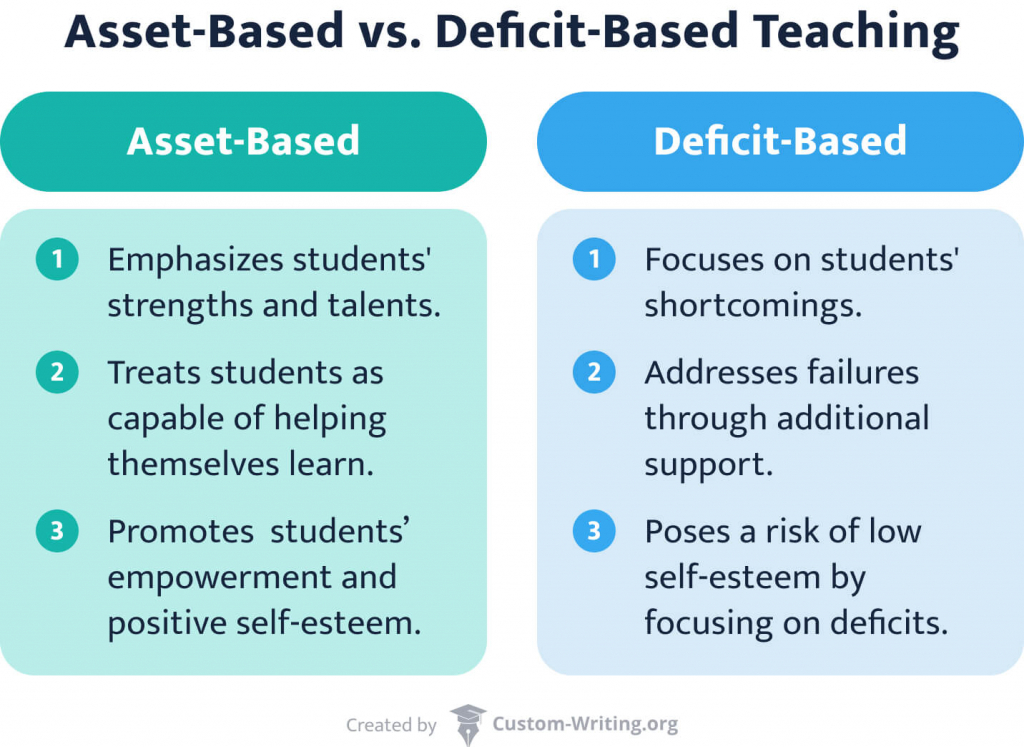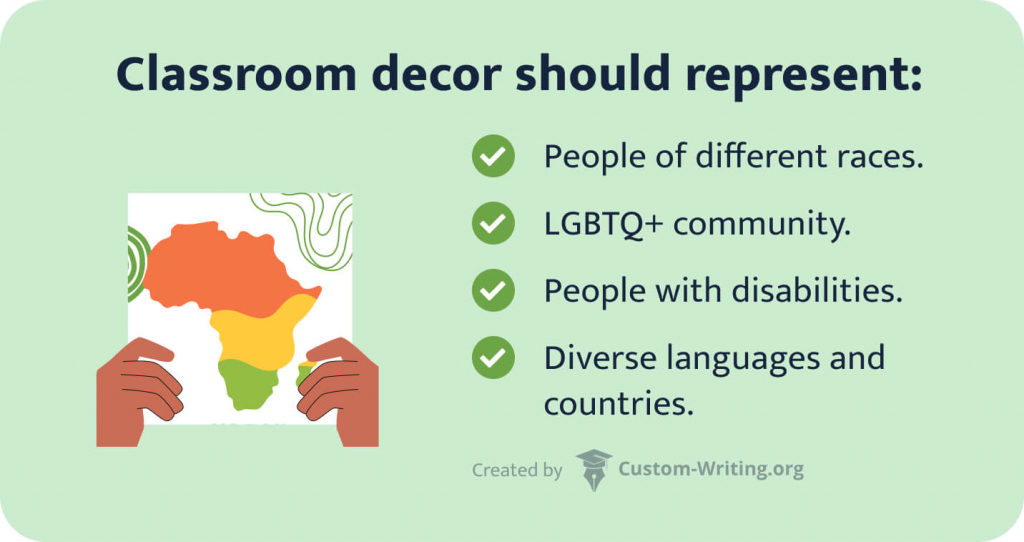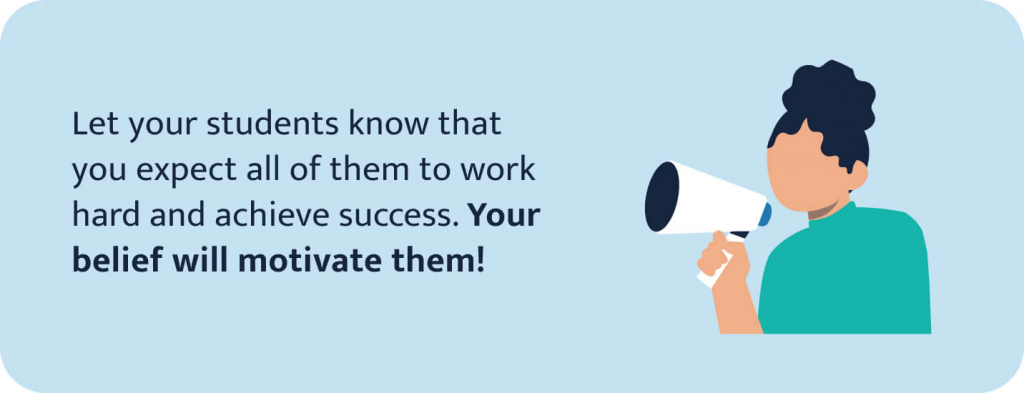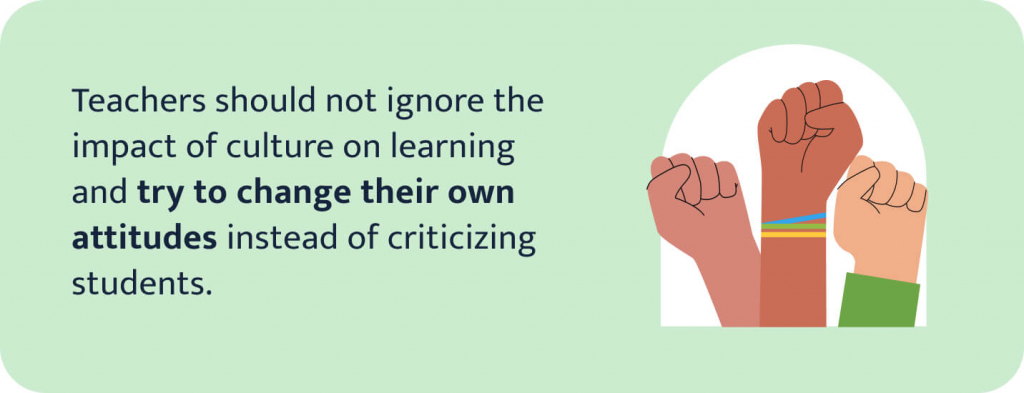Students in today’s classrooms reflect a vibrant tapestry of ethnic backgrounds and cultural identities. It’s no surprise: in recent years, racial diversity in US public schools has increased dramatically. According to research led by the National Center for Education Statistics, more than half of all students are representatives of ethnic minorities. The most numerous are Hispanic (28%) and Black students (15%.)

It’s undoubtedly great that more marginalized students are getting access to education. But unfortunately, most schools are still focused on the white American canon and use practices that don’t properly involve students from ethnic minorities.
Luckily, there is a solution—culturally responsive education (CRE.) It weaves personal experiences and unique traditions together to foster deep connections with students while honoring their ethnic backgrounds.
In this article, our custom-writing team will cover everything you need to implement CRE in your classroom. Here you will find handy tips, best practices, and examples. The article is mainly intended for teachers and parents, but we’re sure students will also find it interesting.
🎓 What Is Culturally Responsive Education?
Before diving deeper into CRE, let’s discuss a trend in education that has become very popular in recent years: the asset-based approach. Simply put, it’s an educational technique that focuses on students’ strengths and regards diversity in thoughts, views, cultures, and experiences as valuable assets rather than obstacles.
For a long time, the main teaching method was to identify a gap in students’ knowledge or skills and try to correct it. This approach is known as a deficit mindset. But the truth is, it’s pretty discouraging for students. Focusing on their weaknesses holds back their curiosity and growth. Students from marginalized communities feel this especially acutely, as they often differ from the standards of behavior, appearance, and language of “privileged white people.”

Asset-based education changed it all. This approach uses the following scheme:
- Accessing what students know and can do. This information will help a teacher to create learning pathways.
- Offering students several learning pathways to choose what works best for them. It shows students that their teacher appreciates their uniqueness and believes they can achieve a lot.
- Giving feedback focused on students’ strengths and discussing the next step they can take to achieve the goal. This focus completely changes both teachers’ and students’ approaches to learning.
Culturally responsive education is, in fact, a part of the asset-based approach. CRE uses students’ customs, characteristics, experiences, and perspectives for better classroom instruction. Sadly, many teachers misunderstand this concept. Well, we’re here to tell you what CRE really is. Keep reading!
Brief History of CRE
It all started with the scholar Gloria Ladson-Billings who got tired of a common discussion of “fixing” students from minorities. She decided to change the whole approach and started looking at Black students’ abilities and traditional knowledge as assets. Ladson-Billings spent several years observing teachers who successfully worked with Black children and found 2 main things they had in common:
- They all set high expectations for their students and encouraged their academic success.
- They valued the community their students came from and integrated themselves into it.
These two commonalities, as well as other beliefs and practices, formed the basis for a culturally relevant pedagogy. In 2000, Geneva Gay created the term “culturally responsive education” to name the teaching method that addresses students’ unique abilities and helps them affirm their cultural identities.
Key Components of CRE
CRE consists of several critical components. They are as follows:
- Teacher’s knowledge about cultural diversity. This includes understanding the values, traditions, and contributions of different races and ethnicities.
- Culturally relevant and diverse curricula. All learning material should be addressed in the context of race, ethnicity, gender, and class. The visual aids should also be diverse.
- Validation of all communication styles. This means understanding students’ means of self-expression and adapting classroom interaction accordingly. For example, many Black students prefer an active participatory communication style that a teacher might misunderstand.
- The use of multicultural examples. This component is about connecting students’ prior cultural experiences with their new knowledge.
- Cultural competence in the classroom. The classroom environment should motivate students to appreciate their culture of origin while learning about other people’s way of life.
- Critical consciousness regarding real-world problems. Classroom assignments, projects, and activities should be closely connected with contemporary issues. Make sure to explain how students can use their knowledge to solve problems they may face, including discrimination and bias.
- Belief in the ability of all students to excel. This means having high expectations for all students despite their gender, race, and culture, and helping them achieve academic success.
- A wide variety of educational content. Rudine Sims Bishop states that classroom education should provide students with “mirrors and windows.” This means that children should see characters and settings that reflect their communities. They should also have access to materials that show them the world of others.
- Dynamic instruction and participation. Ethnic minority students learn in active and diverse ways. Teaching methods should reflect this. Combining discussions, group work, and individual activities will help every student find the most comfortable way to participate and demonstrate excellence.
- Involvement of parents and community. Historical facts or life stories shared by students’ relatives and neighbors will create a bond between the school and the community.
Culturally Responsive Education vs. Traditional Teaching
As you may have already guessed, CRE and traditional teaching differ drastically. See their main characteristics in our comparative table:
When to Use CRE
Some people think that CRE is relevant only when working with students from marginalized ethnicities and only in the United States. This is actually incorrect. Representatives of different races, ethnicities, and cultures live in every country of the world, and CRE is an effective way to ensure that all of them feel comfortable in the classroom. This method is also proven effective when working with students from low socioeconomic backgrounds.
Higher education institutions can benefit from CRE, too. The typical college curricula are designed for white middle- and upper-class students. Culturally and linguistically responsive teaching helps Black, Latinx, Indigenous, and poverty-affected college students use their knowledge to succeed in the education environment.
🏅 Why CRE Matters for Student Learning
CRE truly makes a big difference in learning because it helps all students, especially those from marginalized communities, feel seen, valued, and empowered. They need it more than any other demographic, as the whole curriculum is often created around a culture alien to them while their own unique backgrounds are ignored.

Many students face barriers that have a long-term impact on their desire to learn and their future life. The most common ones are:
- Regular discrimination. This may include punishment in the classroom and authoritarian expectations that make students feel unwelcome.
- Language barrier. The National Center for Education Statistics discovered that about 10% of students in American public schools are not native English speakers. They often have difficulties understanding the material, asking questions, and expressing their thoughts.
- Underrepresentation. Education materials and tests are usually created to represent the racial and ethnic majorities.
CRE is like a bridge that helps to overcome the gaps, engage every student, and stimulate positive relationships between the school and community.
What Does the Research Say?
The benefits of CRE are not just words. They are verified by key research, including the following:
- A study conducted by Brittany Aronson at Miami University in Oxford, Ohio, showed that CRE helps students see themselves as capable learners and increases their motivation and interest in studies.
- Another research highlighted that if school assignments, texts, and projects reflect students’ backgrounds, students engage more readily in profound, meaningful learning.
- A series of smaller studies proved that CRE raised students’ engagement and improved attendance and overall academic success rates.
- Deborah Rivas-Drake found that a solid racial identity formed by CRE helps students to build higher self-esteem and academic attitude. It also increases their ability to navigate discrimination.
- Culturally responsive education has proven effective in improving the overall school climate. Students taught according to the CRE principles are likelier to befriend people of all racial and ethnic backgrounds.
🔮 How to Implement CRE in Your Classroom
Before jumping to actual CRE strategies that you can implement in your classroom, let’s first talk about preparation. After all, culturally responsive education is entirely different from traditional teaching! Your old methods won’t fit into your new classroom strategy, so we recommend leaving them behind and not looking back.
So, here are the 7 steps to implement CRE in your classroom.

1. Get to Know Your Students
Culturally responsive education requires an individual approach. Before starting to plan your new school year, make sure to learn all about your pupils and their culture. Our excellent tips will help you with this:
- Ask the students to tell you about themselves and their family traditions. They may share how they celebrate holidays, describe their family dishes, etc.
- Make a questionnaire about your students’ likes and dislikes, hobbies, and responsibilities outside school. Use this information to tailor your lessons to your student’s interests.
- Interview your students about their favorite subjects and activities. It will allow you to understand what helps them learn and identify their learning style.
- Ask your students to make a project about an outstanding person from their community. It could be a relative, a neighbor, or a historical personality.
- Get acquainted with the parents. They know their child better than anyone and can give you lots of helpful information.
2. Learn to Respect Your Students’ Culture
Here’s another essential part of switching to culturally responsive education. The students in your classroom have their own values, beliefs, behaviors, languages, and lifestyles. All of this makes them unique. That’s why we recommend you take your time to really understand your students. Otherwise, all your efforts will be superficial and won’t do any good.
The best way to learn about each other’s experiences is by listening and sharing. Students should be taught not only to speak out their feelings, beliefs, and thoughts but also to listen to their classmates. Ensure that every lesson includes activities that allow your pupils to celebrate different cultures, both theirs and their peers.
3. Work on Your Implicit Biases
To become a successful CRE teacher, you should do your best to eliminate your biases and not let them influence your teaching. And the first step here is to acknowledge and accept that we all develop prejudices in our lives.
Bias comes in many forms. A person may hold gendered, religious, academic, or cultural stereotypes without even realizing it. You can try to recognize your own implicit biases by answering the following questions:
- Do you think girls are not as good at STEM subjects as boys?
- Do you have different expectations for students of different races or ethnicities?
- Do you believe introverts study worse than extroverts just because they are quiet?
- Do you notice any differences in your behavior depending on your students’ race, ethnicity, socioeconomic status, or language proficiency?
- Are you more likely to overlook or dismiss the contributions of some students?
- Do you unintentionally favor specific individuals or groups?
Of course, realizing your biases won’t eliminate them immediately. However, it will be the first step towards self-reflection and making more informed decisions.
4. Create an Inclusive Curriculum
Now that you’ve learned about your students’ culture and understood your biases, it’s time to create an inclusive curriculum. The main requirement here is to expand the canon and involve diverse education materials, content, and assessment methods. It’s more challenging than it may seem, so read this section carefully.
To ensure a proper representation of all students’ cultures, you’ll need all the information you’ve learned about them. Ensure you’re doing it from a place of compassion. With true understanding and respect, you will be able to create an effective curriculum.
Try also to incorporate your own knowledge into your classroom activities. Think creatively! Consider how you can ensure that all your students’ cultures are represented and celebrated. The transformed curriculum should eliminate colonialism’s legacy that fosters education inequality. Instead, use every aspect of culture as a basis for learning something new.
5. Involve Your Students’ Families
Regular communication with family members is an integral part of culturally responsive education. They can tell you a great deal about the cultural backgrounds of your students. Of course, not all parents will be experts, but all of them have relevant experience which will be a great help to a teacher.
Here are some effective ways to involve parents in school life:
- Send a letter home to parents whenever starting a new unit or implementing a new method.
- Ask your students’ families to contribute to your curriculum by providing cultural context or suggesting something that can help you.
- Include parents in a representative team for preventing harassment and discrimination.
- Invite your students’ family members and representatives of local community groups to conduct workshops or give speeches.
- Ask parents for feedback regarding your teaching methods and their children’s progress.
6. Cultivate Cross-Cultural Communication
Culture has an enormous influence on how we speak. In a multicultural classroom environment, you should understand and accept that the communication style of students from diverse ethnic backgrounds can differ significantly from what’s considered “correct” in mainstream education. Let’s discuss a few examples and compare them:
To cultivate cross-cultural communication effectively, you should do the following:
- know and appreciate the cultural and linguistic peculiarities of your students;
- use the students’ experiences to access their intellectual abilities;
- teach them style-shifting skills so that they can communicate with different people in different settings;
- apply interactive, collaborative methods and strategies in your classroom.
7. Mind Your Classroom Setup
Classroom design is an excellent way to tell your students they are seen and valued. Check out your displays, bulletin boards, and other visual materials. Then, ask yourself the following:
- Do they demonstrate people of different races and cultures?
- Do they display representatives of the LGBTQ+ community?
- Do they include people with disabilities?
- Do they exhibit diverse languages and countries?
- Are all of them represented in a positive context?
Seeing oneself represented is enormously impactful for students’ comfort and ability to learn. How children of different races and ethnicities perceive the classroom environment largely depends on whether they see visual representations of themselves, their homes, and their communities.

The details like color, space arrangement, and sounds also play a significant role. Even the clever positioning of desks can foster a sense of connection and stimulate communication with teachers and peers!
🍀 Top 15 Most Effective Culturally Responsive Strategies
After completing all the preparatory steps, it’s time to move to the main event. We present the 15 best culturally responsive teaching strategies you can effectively integrate into all aspects of education.
1. Keep Language Differences in Mind
To build a culturally responsive classroom, always consider ESL students. They may experience more difficulties than others since English is not their primary language. Here is what you can do:
- Offer additional materials. Instead of expecting your students to cope with a language barrier by themselves, help them out. Find supplemental materials in their native language to help them navigate class content and assignments.
- Integrate their vocabulary into your explanations. You already know what your students are interested in. Now, try to use the language associated with their interests while introducing a new topic. You will grab their attention and make information more accessible.
- Learn some words in your students’ language. If you have ESL students in your classroom, learn and use a few words in their native tongue. It’s a significant step towards considering the students’ native literacy as a resource rather than an obstacle. Besides, they will be delighted to hear their language spoken in the classroom!
Some of your students may also speak the vernacular of their region or social group. To help them feel comfortable and confident, let the children communicate the way they are used to instead of making them use “correct” language.
2. Set High Expectations for All Students
Make sure you motivate all your students to excel. Some teachers unconsciously lower expectations for some children due to their family circumstances and cultural backgrounds. This approach does more harm than good. Instead, let every student know that you expect them to work hard and achieve a lot. Your belief will be a huge motivation for them.
Here are a few excellent tips for creating an unbiased environment in your classroom:
3. Facilitate Empowerment
Empowerment plays a key role in helping students develop self-confidence and self-worth. It allows them to recognize their own abilities, and strengths, enabling them to overcome obstacles and pursue their goals. Try the following to help your students feel more empowered:
- Avoid being authoritative. A classroom with many rules and prohibitions makes marginalized students feel insignificant and powerless.
- Consider being a facilitator rather than an instructor. To do this, focus your lessons on the topics your students find interesting. Let them have a hand in their studies through class discussions, collaborative projects, choosing their own reading, etc.
- Encourage your students to express their thoughts and opinions. It will help them feel like an essential part of the classroom environment.

4. Integrate Real-World Problems
A great way to empower your students and establish a culturally responsive classroom is to offer them the opportunity to solve real-world problems. Here are some ways you can do it:
- Choose issues that are clearly linked to your students and their communities. Asking them to find such connections can also be a great exercise.
- Encourage your students to take different cultural perspectives when working on problems. They can research them from anthropological, historical, and sociological points of view.
- Don’t hesitate to pick a serious problem to discuss (such as racism and social injustice.) You can also question your students about what issues they consider most topical.
5. Invite Guest Speakers
This excellent strategy will allow you to bring authentic experiences into the classroom. Guest speakers can present more than just different jobs and professions. A mountaineer or veteran can vividly explain specific aspects and answer questions the teacher would struggle to answer. Their presentation will help students better understand the topic than a slideshow or video could.
You can ask a guest speaker to represent a specific culture. This is especially relevant for working in a multicultural environment. It’s the perfect way to engage students and educate them about the traditions and peculiarities of different communities.
6. Use Different Forms of Content
All students are different in how they perceive things, respond to new material, and learn it. That’s why using diverse types of content is a must. It helps all students find something that works for them and also keeps things interesting.
For this purpose, you can set up several learning stations in your classroom. At each station, students can work individually or in groups. They can be asked to solve a problem or answer questions using different types of content.
Here is what students can do at the learning stations:
- complete puzzles,
- play educational games,
- read books and articles,
- create artworks,
- watch videos.
We’re sure you can easily add other components to this list. Choose activities that are most effective in your classroom environment, and rotate between them.
7. Try a Call-and-Response Approach
The easiest way to engage all your students is to use a call-and-response approach. It involves actively asking questions during lessons and answering them in unison. A call-and-response style is vital for children of African American, Latino, and Pacific Islander backgrounds, as all these cultures traditionally use chanting and repetition to process information. And you too can use it to make your lessons more exciting.
Here are a few excellent tips:
- call out every student without waiting for a raised hand;
- let all students express themselves;
- ask a question after each new thought or piece of information.
During the lesson, everyone in the classroom should have an opportunity to speak. This way, even the shy ones will get used to speaking in front of their peers.
8. Gamify the Lessons
Want to make your lessons even more engaging? Gamify them!
All students, regardless of their cultural or racial backgrounds, love games. For many ethnically diverse students, oral traditions are a natural way to learn. They love singing songs, solving puzzles, and finding connections between unrelated things. You can easily incorporate such elements into your classroom.
Check out these ideas:
- create a chart and mark the progress your students make toward the clearly defined final goal;
- make a manual with rubrics and methods to earn the highest grade;
- give small rewards (e.g., badges) for getting a certain number of points or completing tasks.
9. Encourage Students to Propose Topics
You can put your students in control of their education by doing the following:
- Ask them to suggest topics for their projects or discussions. Your students will be thrilled to realize they have a choice and can showcase their strengths and interests.
- Allow them to design project formats, from initial idea to completion.
- Encourage them to use their unique cultural experience and background knowledge when proposing topics and creating projects.
10. Use Cooperative Learning
Diverse students are usually communally oriented, and you can use this to enhance their studies. Create cooperative-based groups within your classroom. In these groups, students can practice the following activities:
- organizing reading buddy sessions;
- reviewing lessons;
- completing jigsaw activities;
- answering each other’s questions;
- conducting research;
- completing projects and assignments.
Discussing and summarizing stories and lessons in their own words helps students understand and remember them better. Besides, studies show that children working in groups and pairs better perceive content and score higher on tests.
Your task here is simple:
- Divide your students into small groups of 3 or 4;
- Schedule their meeting times;
- Give them a detailed plan.
Your students’ task is to help and support each other to reach set goals.

We strongly recommend you include elements of competition in your lessons. A bit of good-natured rivalry will increase students’ engagement and interest.
11. Build on Students’ Prior Knowledge
Students who enter your classroom already have plenty of knowledge and experience. The best thing you can do is to build on this capital.
This strategy is crucial if your classroom includes children of minority groups. These students may often feel unseen and unheard. Give them an opportunity to activate their cultural experience and act as experts!
For example, you may choose to read and analyze a book that describes the life of people they closely resemble. But don’t go too far: students should feel like they have something relevant to say, not like they have to speak for all people of their race or ethnicity.
You can also celebrate your students’ backgrounds by displaying an appropriate poem, quote, or picture in the classroom. Another good idea is to engage them in storytelling, creative projects, or free-writing exercises. You can use any educational tools you can think of to connect school and students’ communities directly.
12. Make it Contextual
To make the content more exciting and relevant to your students, link it to their actual lives. For example:
- When discussing past events in a history lesson, explain how they have influenced current affairs in the world. Take this further by explaining why these events matter specifically to their communities or families.
- When teaching literature, you can draw parallels between the text and the modern life or culture your students represent. Ask students to find the connections—you’ll get a lot of creative and unexpected opinions!
Contextualizing will help your students relate to the studied material. At the same time, drawing parallels and building connections develops imagination and critical thinking.
13. Incorporate Popular Culture
Pop culture is an integral part of your pupils’ lives. Sometimes, their whole community is keen on a specific music genre or sport. Using students’ interests to grab their attention is a common practice among teachers. But we recommend you take it beyond that to make your lessons even more culturally immersive.
Try to explain new concepts from the perspective of popular culture. Use music, films, video games, fashion, sports, or any other areas your students are interested in to enhance the learning experience and foster cultural understanding. Here are some strategies to effectively integrate pop culture into culturally-responsive education:
- Promote diverse representation. Choose popular culture materials that reflect a range of diverse identities and perspectives. Ensure that everything is represented authentically and respectfully.
- Connect it with students’ experiences. Encourage them to analyze and reflect on how popular culture shapes and reflects their cultural identities.
- Challenge stereotypes. Analyze how popular media perpetuates or challenges cultural biases. Engage students in critical discussions to develop media literacy skills.
- Explore commonalities and differences. Compare and contrast pop culture elements from different countries or time periods. Pay attention to similarities, differences, and shared experiences.
- Establish interdisciplinary connections. Incorporate popular culture into various subjects, such as history, social studies, and even science and math. This approach will facilitate a holistic understanding of cultural contexts.
- Encourage student engagement and participation. Create opportunities for students to actively engage with popular culture by analyzing it or even making their own artifacts.
- Address social issues. Connect popular culture narratives to real-world problems and encourage students to develop empathy, critical thinking, and problem-solving skills.
While incorporating popular culture, be mindful of cultural appropriation and ensure that the materials are used respectfully. Avoid perpetuating harmful stereotypes or appropriating cultural elements without proper understanding and context.
14. Use Technology
Technology is a priceless tool for culturally responsive education:
- It helps connect with the students’ authentic culture outside of the traditional white-American education system.
- It lets you bridge the generation gap.
- It teaches students confidence in working with technology.
- It empowers students by giving them access to a wealth of information.
- It stimulates critical thinking and scientific inquiry.
However, you need to be careful applying this strategy. It works only with digital natives. It is best to avoid using this technique if your students are unfamiliar with technology.
15. Include Authentic Assignments
In traditional education, students accumulate grade points through tests, quizzes, responses to class questions, and group discussions. When implementing culturally responsive teaching, you need to give your students more opportunities to share their knowledge. You can do this by adding authentic assignments. These tasks evaluate students’ ability to use their skills and knowledge in real-life situations. Here are a few examples:
- storytelling,
- journaling,
- creating a portfolio,
- conducting life history interviews.
All these tasks help engage students and make learning more personal. Don’t forget to explain the purpose of every single assignment to your students!
⚠️ Possible Pitfalls of Implementing CRE
CRE is truly an excellent method. But unfortunately, it has its drawbacks and pitfalls, too. Below, we will describe the most widespread of them.
Bias Among Teachers
The main and most serious drawback of this method is the lack of teachers ready to throw away their biases, accept diverse cultures, and respect their students regardless of their backgrounds.
Many teachers trying to implement this method keep their stereotypical beliefs. The most common bias among educators with a low level of cultural proficiency is a deficit mindset regarding marginalized children. They don’t expect much from their students and tend to blame them for what they lack instead of noticing what they have. Such an approach has disastrous consequences, including:
❌ emerging conflicts,
❌ continuous misunderstandings,
❌ low level of morale,
❌ decreased academic performance.
Teachers who undervalue or completely ignore the impact of culture on the classroom environment often criticize students instead of working on their own attitudes.
Professional development gives educators a set of practical skills to build a culturally responsive classroom environment. The most essential of these skills is the awareness of cultural diversity, understanding of unique values, experiences, and behavior of all students, and appreciation of their great potential.
Treating CRE Practices as a Cure-All
Some educators consider CRE practices a universal method to improve students’ academic performance. They take some techniques and strategies and try to adapt them to traditional teaching practices. And when the outcome doesn’t meet their expectations, they are astonished. So, what did they do wrong? Let’s try to figure it out!
The crucial thing every CRE teacher has to realize and accept is that CRE is much more than just a set of practices. You can’t just take a few ready-made activities and hope to get results immediately.
Actual CRE teaching is based on a profound understanding and acceptance of the cultures your students belong to. Without it, all your efforts will be shallow and won’t work. It can even lead to cultural misappropriation, with marginalized students still remaining unseen, unheard, and discriminated against.
What can be done here? The main thing is to avoid adapting the elements of culturally responsive education to traditional teaching. Instead, approach CRE as a completely new method that requires you to change your teaching style dramatically.

Using Culture as Bait
Applying culture as a hook is a common practice among teachers who want to use culturally responsive education. They don’t understand that mentioning several African American or Latinx icons is not enough to engage students and inspire them to study.
Let’s look at an example. Hip-hop culture is very popular among African Americans, who often use it to express their individuality. A professional CRE teacher can use it to successfully explain real-life concepts to students. But what will happen if someone misunderstands it?
Let’s say a teacher plays a hip-hop song at the beginning of the lesson to get students’ attention. Then they get to analyze the lyrics, find literary devices, and complete worksheets.
Is this an effective integration of hip-hop culture? Not at all! The teacher clearly doesn’t understand the aspects of the culture. In this example, hip-hop serves as a tool to engage students in the mainstream practices of the official curriculum.
Using CRE Practices as a Tool of Assimilation
Another staple of CRE practices is bringing students’ home and community experiences into the classroom. The idea of teaching children based on their family strengths and cultural background is good, but its implementation often takes an unexpected turn.
Instead of building on children’s experiences, some teachers try to overcome them. This situation usually happens when an educator is not really interested in students’ culture and perceives their families and homes as “deficit.”
As a result, the teacher doesn’t reflect on students’ family and cultural experiences to review and make changes to the curriculum. Instead of respecting and considering students’ uniqueness, some educators try assimilating them and bringing their behavior and worldview closer to the standardized norms.
Now you know the potential dangers of changing your teaching methods to culturally responsive education. Hopefully, you will avoid them. Our tips will help you with that.
🎁 BONUS: Examples of Culturally Responsive Practices
In this final bonus part, we present to you the best examples of CRE practices for different subjects. We hope these strategies will inspire you and provide practical ideas on using culturally responsive education in your classroom.
Example of CRE in Math Class
As a math teacher, you can showcase how practical your subject is in the following way:
- Analyze community statistics with your students;
- Ask students to interview a community member who works in a STEM-related field;
- Roleplay a real-world math scenario relevant to their community, like comparing prices in local places;
- Take them for a walk in their area where they can look for geometric patterns or estimate the height of a building they see.
Don’t hesitate to alter your classroom expectations and curriculum to engage your students and demonstrate how relevant math is to their culture.
Example of CRE in English Class
English teachers have numerous opportunities to connect lessons and everyday life. For example:
- Use the text you are currently studying to teach your students the vocabulary they can apply daily. Choose words and terms to discuss racism, feminism, empathy, stereotyping, and other important topics. Your students can create their own definitions and share examples.
- Encourage students to tell stories from their own lives. They must activate the vocabulary to use it in the real world. And the classroom environment should be a safe space for them to share, ask, discuss, and clarify everything they are unsure about.
- Study literature that is written by the representatives of their culture or includes characters with similar experiences.
Example of CRE in Science Class
A cultural approach can be a great way to teach science vocabulary. You have many options here, such as:
- gamify it,
- storify it,
- make it a social activity.
Any of these approaches fit. All of them are based on listening, repetition, and memorization, which are natural ways to gain knowledge for racial minorities.
Most people from diverse racial and ethnic backgrounds greatly value their community. They regard group gain above individual gain. That’s why group activities like those described above are integral to CRE.
Example of CRE in Art Class
It’s vital for students to see artists who look like themselves and create culturally relevant artworks that reflect their experiences. This doesn’t mean you should eliminate the likes of Michelangelo or Leonardo from your classroom. Just complement them with key personalities outside of the Western canon.
All countries, races, and ethnicities have talented artists. Don’t wait for Black History Month or other special occasions to highlight these individuals! Your students live their culture every day, and if you want to create a culturally responsive classroom, do it every lesson. The large pool of diverse artists from all over the world can help you with that.
All students deserve a just classroom environment where their uniqueness and experiences are acknowledged and appreciated. Use our tips and strategies to create such a climate for your students. Good luck! We are sure the response you’ll receive will be worth all your hard work.
🔍 References
- Valuing Student Experiences: An Introduction to Culturally Responsive Education (CRE): US Department of Education
- A Framework for Culturally Responsive Teaching: Association for Supervision and Curriculum Development
- The Other CRT: Culturally Responsive Teaching: Inside Higher Ed
- Culturally Responsive Teaching Strategies: Importance, Benefits & Tips: School of Education
- Culturally Responsive Teaching: University of Northern Iowa
- Making Practices Culturally Responsive: University of California, Berkeley
- Culturally Responsive Teaching: Examples, Strategies & Activities for Success: Prodigy
- Culturally Responsive Strategic Planning: UW-Madison
- How to Develop Culturally Responsive Teaching for Distance Learning: KQED
- Culturally Responsive Classroom Management Strategies: University of British Columbia
- A Guide to Culturally Responsive Teaching and Resources: Routledge
- Culturally Responsive Education: Wisconsin Department of Public Instruction
- A Guide to Inclusive Curriculum and Educational Practice: Queen Mary University of London
- How to Design and Implement an Inclusive Curriculum: LinkedIn
- Why Cross-Cultural Communication Is Important—and How to Practice It Effectively: University of Pennsylvania
- What Is Cross-Cultural Communication (with Benefits): Indeed
- Call and Response: Columbia University
- Gamification For Learning: Strategies And Examples: eLearning Industry
- Cooperative Learning: Carleton College
- Collaborative Learning: Cornell University
- Culturally Responsive Teaching Guide (+10 Examples): University of San Diego
- Culturally Responsive Practices: NJ.gov
- Culturally Responsive Practices for Equity in the Classroom: The University of Vermont
![How to Organize a Successful Study Group [GUIDE]](https://custom-writing.org/blog/wp-content/uploads/2023/04/doing-homework-together-1-284x153.jpg)

![The Scaffolding Technique in Education: Benefits & Examples [Is It Really Useful?]](https://custom-writing.org/blog/wp-content/uploads/2023/03/business-women-signature-document-1-284x153.jpg)








![How to Deal with FOMO in College [+Turn It into JOMO]](https://custom-writing.org/blog/wp-content/uploads/2022/10/smiling-african-student-pointing-with-pencil-laptop-screen-concentrated-blonde-woman-glasses-propping-chin-with-hand-while-working-with-computer-office-1-284x153.jpg)
Will share!